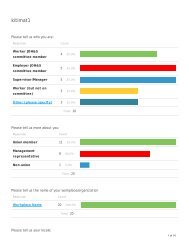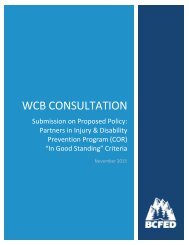KITIMAT DRAFT Report
You also want an ePaper? Increase the reach of your titles
YUMPU automatically turns print PDFs into web optimized ePapers that Google loves.
Figure 10<br />
Utilization of Disability Prevention Principles<br />
Attribute #8 - Key Research:<br />
A permanent modification of the pre-injury job is the most advantageous form of modified work.<br />
Yet in the Institute for Work & Health study of 1500 BC workers mentioned above, only 3.5<br />
percent reported they were offered layout or equipment changes to their work station. Temporary<br />
modifications such as reduced hours, a flexible schedule and lighter jobs were repeatedly offered to<br />
15 percent, 13 percent and 28 percent of workers respectively. Neglecting to alter the pre-injury job<br />
leaves open the possibility for recurrent episodes of back pain in the future. (NIOSH Musculoskeletal<br />
disorders and workplace factors: US Department of Health and Human Services – 1997)<br />
Work disability involves multiple factors and there are now a number of well-recognized disability<br />
prevention strategies offered as part of comprehensive, occupational rehabilitation services<br />
that have been successfully piloted in different countries. These strategies mainly target specific<br />
biopsychosocial and environmental/workplace factors in an attempt to facilitate the RTW and SAW<br />
(healthy stay at work) processes. However, such models require a contextual adaptation in order to be<br />
successfully implemented in a given country. They also require joint agreements, good cooperation<br />
among stakeholders and a common understanding of the consequences of work disability. (Costa-<br />
Black, Chen, Li & Loisel – 2011)<br />
Return-to-work interventions that include a workplace component result in improved vocational<br />
outcomes for workers disabled due to a health problem. This effect has been demonstrated<br />
internationally, across a range of conditions and workplaces and the impact of workplace interventions<br />
is greater than medically-focused interventions that lack a workplace component.<br />
Focus group discussions revealed that nurses are more frequently involved with both coordinating<br />
RTW and managing medical care. Thus, they may need specific medical evaluation skills, knowledge<br />
about treatment efficacy and best practices. This knowledge may be useful for other RTW coordinators<br />
without this role but was not found to be essential.<br />
<strong>DRAFT</strong><br />
Conversely, those with vocational counselling backgrounds were more likely to be directly<br />
involved with not only coordinating the RTW process but evaluating and designing specific job<br />
accommodations. These activities require skills in work capability evaluation, job task analysis, and<br />
a high degree of integration into the worksite, more so than other RTW coordinators without these<br />
responsibilities. (Pransky et al – 2010)<br />
Situational assessment<br />
District of Kitimat<br />
43





